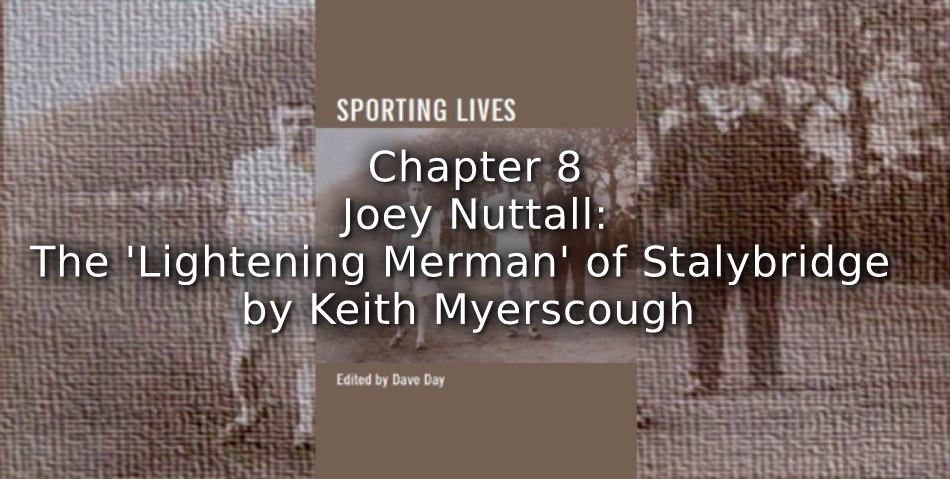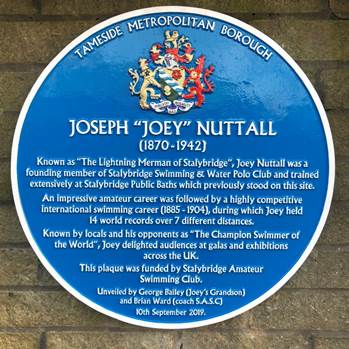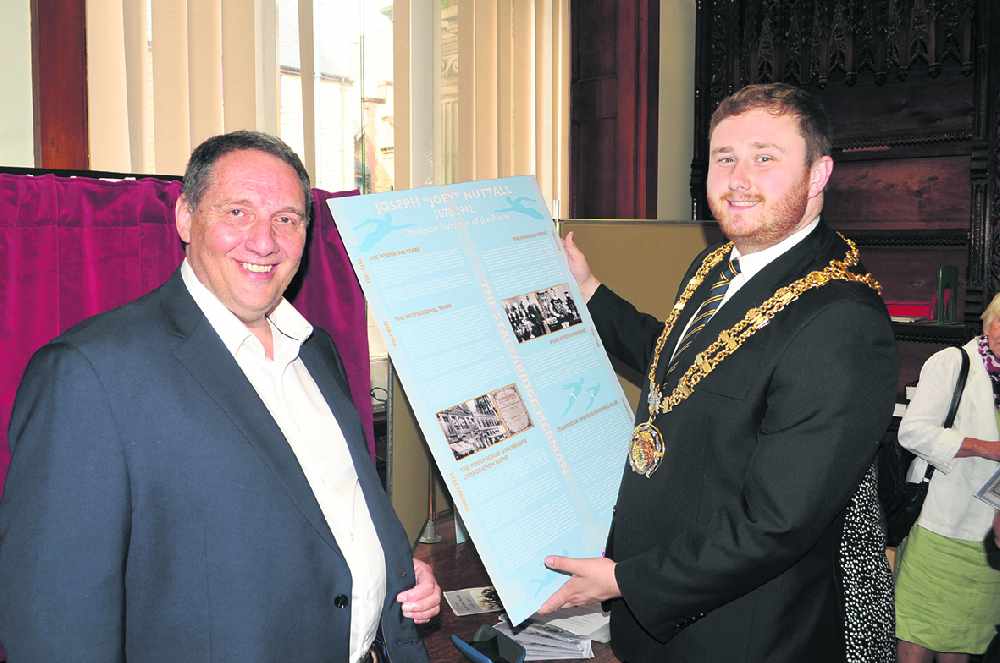Playing Past is delighted to be publishing on Open Access – Sporting Lives, [ISBN 978-1-905476-62-6] a collection of papers on the lives of men and women connected with the sporting world. This edited volume has its origins in a Sporting Lives symposium hosted by Manchester Metropolitan University’s Institute for Performance Research in December 2010.
Please cite this article as:
Myerscough, K. Joey Nuttall: The ‘Lighening Merman’ of Stalybrige, In Day, D. (ed), Sporting Lives (Manchester: MMU Sport and Leisure History, 2010), 112-125.
8
______________________________________________________________
Joey Nuttall: The ‘Lightening Merman’ of Stalybridge
Keith Myerscough
______________________________________________________________
Introduction
It was against a background of great social and economic upheaval that Joey Nuttall found a means of earning a living outside his family home in the Lancashire mill-town of Stalybridge. As industrial migrants, the Nuttall family had moved some six miles (10km) from Hulme, in Manchester to Stalybridge in 1870. At this time Joey was only a year old but the new public baths was to provide the family with a means for ‘rational recreation’ and an opportunity to bathe their bodies and wash their cloths in purpose-built facilities.[1] Joey and his siblings were to grow up in an environment where the baths became a central focus of their early lives. Having outgrown the ‘novelty’ of swimming in the local Huddersfield Narrow Canal and washing in the River Tame, the Nuttall family were to make full use of the local ‘penny scrub’. By 1884, at the age of fourteen, Joey was earning a living as a coal hawker during the day and entering swimming events in his leisure time; his destiny to be determined through his exploits as a ‘speed’ swimmer.
Throughout the 1870s the Stalybridge Baths Committee controlled all aspects of the facilities provision, enthusiastically promoting swimming as a means of generating extra income. The baths not only encouraged the take-up of recreational swimming by the local community in large numbers but also served to promote the use of the baths as a very profitable venue for swimming galas. In the first week of the baths operation over two thousand visits had been made, with the Ashton Reporter suggesting that, ‘With the cleanliness, privacy, and completeness of the arrangements of the new baths we are in strong hopes that during the summer months our canals will be denuded of bathers, even of the poorer classes.’[2]
The growth of the swimming gala as a form of recreational entertainment was dependent upon the rate at which local councils adopted the principle of providing public bathing facilities. The Baths and Washhouses Acts of 1846 and 1847 had helped to establish the principle of promoting public hygiene and the ideological pursuit of physical culture as a responsibility for local authority governance. The reluctance of local council’s to make provision for swimming was based upon a Victorian doctrine that celebrated fiscal prudence whilst promoting the notion of self-improvement. It was left to the local entrepreneur to make provision for indoor bathing facilities based upon growing public proclamations of its benefits to the development of both body and soul. It was not until the 1870s that local authorities within the industrial heartland of Britain reluctantly began to provide publicly owned baths and wash-houses for their communities. This provision was haphazard throughout the rest of the nineteenth-century and was initially dependent upon local businessmen with a philanthropic predilection towards their local communities.[3]
The need for sound fiscal management of swimming baths had driven the sport into the hands of the new leisure entrepreneur in the late-Victorian period. Joey Nuttall benefited from the status of swimming in the 1880s and 1890s when he became the focal point for the split of the Professional Swimming Association (PSA) from the Amateur Swimming Association (ASA). Nuttall was seen by the new leisure elite as a participant who represented the worst excesses of the professionalization of swimming.[4] The draw of large crowds to witness swimming challenges and the large sums of money being gambled on the outcome attracted the attention of the ‘wrong sort’ as far as the swimming authorities were concerned. The entertainment value of swimming exhibitions of scientific natation was considerable and drew large audiences. By the 1880s many ‘champion swimmers’ viewed the swimming gala circuit as a logical career move in becoming a professional natationist. It was the domain of the swimming instructor or ‘professor’, and quite often their families, as it provided them with a means of earning a good living to supplement their teaching. The promotion of aquatic exhibitions not only became an integral component in the staging of swimming galas but it also enabled its practitioners to earn a more reliable living on the ‘bread and butter’ variety theatre circuit.[5] From the 1890s to 1914 an exhibition of natation often appeared on the schedule at many of the variety theatres throughout the UK.[6] Indeed, many of the theatres that were built during the late-Victorian and Edwardian periods had a water tank constructed under the stage.[7]
Amateur Champion, 1881-1888
Nuttall’s home-base at Stalybridge Public Baths served him well in his formative years; it was not through expert tuition that he honed his skills but rather through regular competition at local swimming galas throughout the region. As his fame spread he was invited to swim both in ‘open-’ and ‘still-water’ races throughout the UK. Joey’s exploits as an amateur swimmer began in 1881when he became ‘boy champion’ at the age of twelve and concludes at Lambeth Baths, London by winning the 220 yards Championship of the World for the second time in 1888. His dominance of swimming was such that:
He has met and defeated every Amateur of the day, and travelled over 6000 miles, competing for Championship Honours winning 18 Championship Races in succession out of 20, and over 150 prizes, including 25 guinea and 15 guinea Cups, 25 guinea Watch, 20 guinea Diamond Medal, 15 guinea Silver Fruit Vase, 10 guinea Medal, and holder of [the Ulph Challenge Trophy] 100 guinea Cup.[8]
On October 06, 1886 Joey had claimed his first world title at the age of seventeen when he became the 500 yards Champion of the World at Lambeth Baths in London. In 1887 Joey was the amateur world champion at five distances: the mile (in open water), half-mile, 500yds, 220yds and 100yds. From 1886-1888 Joey had won the 500yds amateur world championship for three consecutive years; he had won the Ulph Cup in two consecutive years, 1887 and 1888; he was the 100yds amateur world champion for three consecutive years, 1886-1888; and he was the 220yds amateur world champion for two consecutive years, 1887 and 1888. [9]
Alas, Nuttall was not without his detractors for when he was defeated in the mile and half-mile open water championship races at Welsh Harp, Hendon in July, 1888 some of the press reports were very critical of his efforts. It was suggested that this was the end of Nuttall’s dominance of the swimming scene in Britain, some newspapers were questioning his preparation for both events and that he now considered himself unbeatable. The Stalybridge Reporter came to his defence by offering an insight into his life-style as a prominent amateur swimmer:
… tobacco and alcohol were avoided, early to bed and early to rise was the rule, and good long walks, with plenty of swimming, were indulged in every day. This, with good food, carefully prepared by his mater, brought him in good enough condition …[10]
The most bizarre event in the history of the ASA and of Nuttall’s amateur career was to occur at the 220 Yards Amateur Championship race at Lambeth Baths on Monday, October 08, 1888. Nuttall had won the event the previous year but due to the entrenched stance being taken by the ASA on the eligibility of competitor’s and the value of the prizes awarded, the top amateur swimmers in the country had taken a collective decision not to race. Many newspapers reported the race entries to be the ‘worst ever received’ and that the actions of the Association had raised the issue of reform.[11] It would appear that many of the country’s elite swimmers had long considered the actions of the ASA to be an ‘interference with the rights and privileges of swimmers’.[12] The threat was that undisclosed parties would set up their own rival amateur swimming association which would result in ‘a rapid transformation of amateurs into professionals’.[13] The swimmers and their financial backers wanted a definition of an amateur that would permit:
The two sections [amateur and professional] … to test their relative merits for prizes other than money. But now an amateur must not swim an exhibition race with a professional swimmer, but the same amateur is allowed to compete in many other branches of sport with professionals at meetings where filthy lucre is charged for admission. And yet a professional at one sport is a professional at all.[14]
Comment was made in the local and national sporting newspapers that ‘the 220yds championship of 1888 is not likely to be forgotten by swimmers for some time to come, as it has led to several protests, objections, &c.’ Commentary on the situation by Jim Hardman of the Stalybridge Reporter, who wrote under the pseudonym ‘Cork Belt’ added to the speculation that Nuttall was being led in his actions by others behind the scenes with a vested interest in competitive swimmers being financially recompensed for their efforts. A witness to the events at Lambeth Baths was Mr Edmund J. Wakeling who was president of the Pacific Swimming Club, and commented thus:
The 220 yards championship has evidently been boycotted, and the question is for what reason and by whom. Is it Nuttall? Oh, no. Nuttall swims although it is only a medal. I excuse Nuttall for not sending in his entry, because I do not believe he knows anything at all about what he is doing, but is being advised by one of our biggest ‘pot hunters’. What man with any sense would advise the association to give a challenge cup without first knowing where the money comes from. If our big ‘pot hunter’ has such a great desire to see a challenge cup why does he not either give a cup or else advise someone else to do it, for he (the pot hunter) has not done so badly out of swimming?[15]
This statement provides further evidence that Nuttall was being manipulated by powerful forces that clearly had a vested interest in attracting the best swimmers to compete for prizes worthy of their efforts.
The 220 yards National Championship was to prove to be a defining moment in the relationship between the ASA and club swimmers. Many of the best swimmers in the land had excluded themselves from the 220 yards championship race because of the stance the ASA was taking on the question of professionalism in swimming. The countries top amateur swimmers viewed the stance taken by the ASA in defining the term ‘amateur’ as being unfair to those dedicated club swimmers who simply wished to compete in exhibition races against professional swimmers. The position adopted by the ASA was seen to ‘severely strain’ the definition of the term ‘amateur’. The consensus of opinion amongst the club swimmers was that the amateur and professional swimmer should be ‘permitted to test their relative merits for prizes other than money.’[16] The inconsistency of approach appears to be the main concern rather than issues of professionalism.
The events of that night were described as being ‘more a burlesque than a reality.’[17] One of the four entrants, Walter Brickett declined to start the race and formally ‘lodged a protest against the illegal resolution of the Amateur Swimming Association.’[18] This act left a field of three competitors, but unknown to them Joey Nuttall had arrived in secret with the intention of swimming should the ASA force the issue. The situation was then inflamed by Messer’s Smith, Welch and Jorneaux who insisted upon being given the opportunity to challenge for the championship title. Nuttall appears to have reacted forcefully to this affront by concocting and executing a plan of action designed to cause maximum embarrassment to the ASA. It is questionable as to whether Nuttall had the wherewithal to plot and carry out the protest on his own cognisance. He was a shy and poorly educated man who could not have expressed himself in the written word as displayed in ‘his’ letter of protest. He disliked the attention heaped upon him because of his phenomenal swimming exploits and would certainly not have welcomed the attention his actions that night in the pool inevitably brought him.
The remaining three challengers were determined to swim so Nuttall appeared bath-side ready to race. A letter explaining his actions was given to a journalist from the Sporting Life at bath-side for publication:
Sir, – I should be thankful if you will kindly do me the favour of inserting the following letter:- In consequence of the action of the A.S.A in withdrawing the challenge cup, which was put up according to rule, and giving a medal in its place, and having signed the petition, which was published in your issue of Wednesday last. I had intended not to help the association to break its own rules by not swimming for the prizes put up. But, to my surprise, I found that a few second-class men thought fit, under the circumstances, to start for the medals; hence my starting as a protest against these would-be champions. In conclusion, I fail to understand what logical objection the A.S.A can have to giving as a cup the price of three separate wins.
P.S – I, Joseph Nuttall, beg to state that I start protesting against the race being swum, as it is held contrary to Rule 70, and in consequence of not being cognisant of the rule on previous occasions, I took no action.[19]
During the race Nuttall poured further scorn on the Association by waiting at each turn for his opponents to catch up with him. He eventually won by four yards to ‘a burst of laughter and ironic cheers’ in the slowest time ever recorded for this championship race of 3 mins 15 and 3/5 secs.[20] Nuttall turned professional some ten days later on Thursday, October 18, 1888 at the Lambeth Baths, the very scene of his protest against the prejudice being displayed by the ASA.
Professional Champion and Aquatic Entertainer, 1888-1907
The PSA held its annual 1,000 yards Topping Challenge Cup race at Lambeth Baths ten days after the ASA had held its 220 yards amateur championship race. The main attraction was the appearance of Joey Nuttall in what was to be his inaugural race as a professional swimmer. The public’s interest in the race was said to be ‘widespread’ as the fame of Nuttall as an amateur had not gone unnoticed within the ‘sporting classes’.[21] It must have been a promoters dream, having the world amateur champion now competing against the pick of the countries professionals. The ASA had gifted the professional circuit their best swimmer and crowd-puller in their decision to ignore article 70 of their Association rules with Nuttall having ‘decided to shake off the thrall of amateurism, and make his plunge into the professional ranks’.[22]
The week before the race considerable interest had been generated by various newspaper articles that speculated as to the wisdom of Nuttall’s decision. The task before him was considerable as he would be swimming against ‘such famous professors of the art of natation’ as: James Finney (the holder of the Topping trophy), J.J. Collier (the ex-champion from Salford), Charles Beckwith (son of the famous Professor Beckwith), and G. Kistler (from Penzance).[23] The race had attracted so much interest that there was standing room only at the time of the race. There were a number of well-known ‘racing men’ in attendance and betting was said to be brisk. The betting odds at the start of the race were: Evans-Nuttall, 2-to-1 against Finney, 4-to-1 Collier, and 10-to-1 Kistler. After the first length of the race it was clear that Nuttall would triumph as he totally dominated the race. Collier finished in second place, some 20 yards behind Nuttall who claimed a new record time of 14 mins 17 and ½ seconds.[24] Nuttall proved to be a success from the outset of his professional career both with the swimming and gambling fraternities. The dominance of Nuttall’s performance and the ease with which he dispensed with the ‘cream of the professionals’ certainly encouraged a healthy interest in the world of professional swimming and in particular, the career of Joey Nuttall.
By 1890 Nuttall’s dominance was such that despite large crowds at the PSA Championships at Lambeth Baths little interest was being shown in betting on the 1,000 yards challenge cup race. The event was one of the ‘chief races of the professional season’. However, the result was considered to be a foregone conclusion such was the dominance of Nuttall.[25] Some of the best professional swimmers in Britain were to challenge for the cup, more in hope than expectation, such was the dominance of Joey at this time. Nuttall had won the event the previous two years and there was little to suggest that any one of the ‘five well-known professors’ (J.F. Standing, R. Foster, J.J. Collier, Reddish and J.H. Taylor), would be able to take his title away from him.[26] Indeed, odds of 20-1 were offered against his closest rivals, J.F. Standing of Manchester and R. Foster of Salford. The dominance of Nuttall could not have pleased the book-makers but at least he had the ability to attract large crowds of spectators to aquatic events in the 1890s. Nuttall won the race by 108 yards in a new record time of 13 mins and 55 secs, lapping his opponents in the process several times. His dominance was further underlined with the Topping Cup being presented to him in perpetuity as it was Nuttall’s third consecutive victory.
In December, 1890 Nuttall, Standing and Taylor were appearing at the Royal London Aquarium in six nights of swimming handicap races with prize money of £120 on offer.[27] The entrance fee for spectators was one shilling or two shillings for a reserved seat. The aquatic entertainment was organised and paid for by the famous Beckwith Family. The father, Professor Beckwith was an ex-champion swimmer and manager to his famous daughter Agnes Beckwith. The financial rewards for professional swimmers were considerable if they toured the country appearing in swimming club galas. The professional races attracted ‘professors’ of swimming to challenge for either expensive gift’s that could be sold on and/or for prize money. In August 1892, Nuttall appeared at the Exeter Swimming Club annual gala where he won thirty shillings for the 100 yards race and £6 for the half-mile Grand Challenge Race.[28] In total, the swimming club provided £100 in prizes for fourteen events, which included a water polo match. Whilst this gala followed a now tried and tested formula it was unusual in that the events took place not in a swimming baths but in the local canal at ‘the Turf’. In the August of 1893 Nuttall took part in an International Swimming Championship contest for prize money of £500 and a championship cup. The challenge came from American swimmer, J.L. McCusker and took place at Hollingworth Lake near Rochdale in water described as being of a ‘comfortable temperature’ on ‘open still water’.[29] Nuttall beat McCusker comfortably by over 200 yards in a time of 26 mins and 8 secs, beating the old record set by J.J. Collier in 1884 by two minutes.[30]
Nuttall’s services were very much in demand by 1893 as his presence would certainly attract large paying crowds to swimming events. In September 1893 he was hired by Captain Boyton’s World’s Water Show at West Brompton, in order to compete in a proposed swim off with the American champion, J.L. McCusker and ex-amateur English champion S.W. Greasley of Leicester; McCusker did not enter the race and Greasley came a disappointing second by 25 yards to Nuttall.[31] Nuttall collected a gold medal to the value of twenty guineas and prize money of ten guineas.
In 1894 Nuttall embarked upon a new phase in his swimming career by appearing in the aquatic entertainment show at the newly opened Blackpool Tower Aquatic and Variety Circus.[32] This was a seasonal commitment from April until the end of August, appearing three times a day in the aquatic show. His exhibition of speed swimming was but one part of an extensive show performed by a whole host of professional swimmers earning a living by displaying ‘the art of natation’.[33] Each season for the rest of the decade brought a cast of some of the most famous swimmers in Britain to the Tower Circus. Although Nuttall appeared on the programme he was never given the title of ‘professor’. This may well be because he had never earned a living as a teacher or instructor and he certainly never performed anything other than his exhibition of ‘fast swimming’. He was either unwilling or unable to perform the vaudevillian feats labelled as being ‘scientific exhibitions’ of ornamental swimming which were so desired by audiences who simply wanted to be entertained in their newfound leisure time.
By the summer of 1897 Nuttall was establishing his international reputation by challenging the Australian professional swimmer, British émigré Ernie Cavill, to a race at Roundhay Park, Leeds. Nuttall declared that he needed two months in order to meet any ‘stake suitable to the Australian.’[34] The ‘Great National Swimming Race’ took place on Wednesday, September 08, 1897 in order to take advantage of the sporting crowds that were in town for the St. Leger horse race. [35] Nuttall started as the favourite for the £200 prize money, with odds of 7-1 against Cavill which accurately reflected the gap in abilities between the two swimmers. Nuttall completed the 500 yards in a time of 6 mins 50 and 1/4 secs; Cavill left the water on the eleventh length of the pool as he was a full length behind Nuttall.[36] Nuttall was now considered to be invincible with many prospective opponents withdrawing from challenging him. In October 1897 he was competing at the Edinburgh Baths in Scotland as a guest at the Rosebery Swimming Club Gala in the 220 yards race; Nuttall having set the record some two years earlier at 2 mins and 37 secs. The club had organised international competition for Nuttall in the shape of three Australians, Cavill, Hellings and Lindley only for all three of them to withdraw at the last minute.[37] On October 29, Nuttall had moved down to Sunderland in order to swim in the Sunderland Swimming Club Annual Gala where he was to attempt to break his own world record over 200 yards.[38] Despite suffering from an abscess under his arm Nuttall did reduce the record to 2 mins 23 and 1/5 secs on that occasion.
In September, 1898 Nuttall’s dominance of the professional indoor circuit at the mid-distances had led one backer to issue a challenge to any swimmer other than Nuttall. The barring of Nuttall from the £200 a-side wager served to announce the beginning-of-the-end for Joey, ironically not because of his declining abilities but because he was no longer a man who attracted wagers. J.H. Tyers and E. Cavill were invited to take up the challenge. Nuttall continued to tour the various local galas offering his name as a draw for paying spectators. Many of Nuttall’s races were now being described as swimming exhibitions; Nuttall and Tyers raced each other over four lengths (156 yards) of the Osborne Street Baths, Manchester in October, 1898. The outcome was a dead-heat in a time of 1 min and 57 secs.[39] The dead-heat was repeated by the duo at the Leeds Swimming Club gala in the January of 1899 when they conspired to achieve the same outcome over 250 yards. The Leeds Mercury commented that both swimmers ‘seemed to cover twice the distance of the average amateur with half the effort.’[40] The success of their exhibition races encouraged further ventures in 1900 when Nuttall and Tyers appeared at Lambeth Baths to swim in aid of the Music Hall Home fund, sponsored by the Sporting Life.[41]
By 1902 it would appear that Nuttall’s superiority in speed swimming was ebbing. At Hampstead Baths in July, 1902 he failed to beat his own record time for the 500 yards by a full 13 seconds at 6 mins 37 and 1/5 secs. He had only set the current world record a year before in Leicester.[42] In September 1904 The New York Times reported that Nuttall had won first prize in a race around the inner harbour of Newport, Rhode Island. The course was three miles in length with Nuttall winning in a time of 1 hour 35 mins 30 and 2/5 secs. His opponents were: Percy Cavill of Australia, who finished second, and in third place was John McCusker of Boston USA. For his efforts that day Nuttall won a gold medal and $450, second place got $150 and third place won $75. Nuttall was to face the two main protagonists repeatedly throughout his professional career almost exclusively in the UK.[43] In September, 1905 it was reported that Nuttall had competed in an inaugural competition to swim in the River Seine, France. There were over 800 entrants with about 100,000 spectators along the seven-and-a-half-mile course to witness Nuttall fail to complete the distance due to cramp.[44] By 1907 Nuttall had retired from competitive swimming and opened a public house in his home town of Stalybridge. [45] He was landlord of the Greyhound Inn from 1907-1910 when the beer-house closed down; it would appear that Nuttall was in considerable debt to the brewery who claimed most of his trophies in part payment for his debts. Sometime after 1911 Joey left his hometown of Stalybridge in order to take up residence in Blackpool, where he had been fêted as a natationist and entertainer.
Conclusion
Joey Nuttall is a significant figure in the world of Victorian natation not only because of his dominance of ‘speed swimming’ but also because of the stance he took against a leisure elite who attempted to limit his earning potential as a swimmer. His ‘sporting life’ exemplifies the veracity of the late-Victorian puritanical mind-set towards the professionalization of sport and the pursuit of respectable forms of recreation.[46]
The ‘ownership’ of competitive swimming was essentially dominated regionally by local swimming clubs who saw the imposition of draconian codes of conduct by those in governance as a means of restricting their income. The conundrum faced by talented working-class swimmers was not so much how to earn a living as a swimmer but rather, how to supplement a ‘respectable’ living with the pecuniary rewards associated with success on the swimming gala circuit.[47] The value of a trophy and the payment of legitimate travelling expenses appear to have been clouded by the sports inextricable links with gambling and the new phenomenon of the leisure entrepreneur. It was against this backdrop that Joey performed as an ‘amateur’ swimmer from 1881-1888 and then as a ‘professional’ swimmer from 1888-c1907.
Although Joey continued to perform at the highest levels as a professional swimmer, post-1888 he was forced to supplement his income from competitive racing by performing as an aquatic entertainer in leisure destinations such as Blackpool.[48] From exhibiting his talents within the comfort of local swimming galas he was now reluctantly entertaining the masses at sea-side resorts and open-water shows. The trend for the working-classes to escape the confines of their industrial environment for that of leisure destinations was fully exploited by the new leisure entrepreneurs and provided the opportunity for Joey to earn a living as an aquatic entertainer. A ‘profession’ that provided inclusive employment for both male and female natationists. The dominance of those earning a living in employment associated with swimming (baths attendants, coaches/instructors and, increasingly aquatic entertainers) merely served to stiffen the resolve of the sports administrators to limit their influence. The stance being taken by both sides finally came to a head at the National Swimming Championships in October, 1888; a defining moment in the history of swimming in the UK. The ASA, who had been established in 1886, eventually gained exclusive control of swimming with the demise of the PSA in 1891 and the subsequent decline in popularity of aquatic entertainments by 1914.
Joey was not only a real champion of natation but an iconic figure to the inhabitants of Stalybridge in that he espoused the benefits of a work ethic that had provided him with a means of self-improvement and self-reliance, which made him a productive member of Victorian and Edwardian society. Research to date indicates that Joey may well have involved himself in coaching J.A. Jarvis to some degree but further investigation is necessary in this respect. The success of Jarvis appears to be as a result of the development of the ‘Jarvis-Nuttall Kick’ which brought Jarvis international success at the 1900 Olympiad in Paris and the 1906 Intercalated games in Athens.
The personal sacrifices Nuttall made in achieving sporting excellence came at a price; Joey married in 1906 at the age of 37 and he died in 1942 at the age of 72, being buried in an unmarked grave, his occupation declared him to be a ‘general labourer, retired’. How different it may have been if Joseph Nuttall, Champion Swimmer of the World, and holder of 14 world titles could have plied his trade in this modern era of the iconic professional sports superstar.
Note from Playing Pasts editor – in 2018 Keith was instrumental in a blue plaque in Joey’s honour being unveiled at Stalybridge Library. Read the local newspaper report by clicking HERE
References
[1] Bishop Bloomfield spoke of the bath-house as a form of ‘social salvation’ in the House of Lords (1846), quoted in Peter Bailey, ‘Leisure and Class in Victorian England: Rational Recreation and the Contest for Control, 1830-1885’, (London: Methuen & Co. Ltd., 1987), 63.
[2] Ashton Reporter, ‘Opening of the New Baths at Stalybridge’, May 14, 1870, 4.
[3] Christopher Love, ‘A Social History of Swimming in England, 1800-1918, Splashing in the Serpentine’, (London: Routledge, 2008), 53
[4] Claire Parker, ‘The Rise of Competitive Swimming 1840 to 1878’, Sport in History, 21 No.2 (2001): 54-67.
[5] William Broadhead owned sixteen variety halls often referred to as the ‘Broadhead Circuit’ where he provided aquatic acts. He also owned and ran the Prince of Wales Baths, Blackpool.
[6] The Bristol Hippodrome (1912) had two tanks holding 100,000 gallons.
[7] There is still a water tank under the circus stage at Blackpool Tower, built in 1894.
[8] A Sidebottom, ‘Joey Nuttall’, 1888. See also, Coggan’s Tailoring, ‘Records and Championships of Joey Nuttall, Champion Swimmer of the World’, 1890.
[9] Coggan’s Tailoring, 1890.
[10] Stalybridge Reporter, ‘Joey Nuttall’s Defeat, To the Editor of the Reporter’, August 4, 1888, 5.
[11] Stalybridge Reporter, ‘The 220 Yards Swimming Championship’, October 13, 1888, 5.
[12] Ibid, October 13, 1888.
[13] Ibid.
[14] Ibid.
[15] Stalybridge Reporter, ‘Swimming Notes’, October 13, 1888, 5.
[16] Stalybridge Reporter, ‘The 220 Yards Swimming Championship’, October 13, 1888, 5.
[17] Stalybridge Reporter, ‘The 220 Yards Swimming Championship, Easy Victory for Nuttall’, October 13, 1888, 3.
[18] Stalybridge Reporter, ‘The 220 Yards Swimming Championship’, October 13, 1888, 5.
[19] Ibid, October 13, 1888.
[20] Ibid.
[21]The Stalybridge Reporter, ‘The Thousand Yards Swimming Championship, Joey Nuttall Turns Professional and Beats the Record’, October 20, 1888, 8.
[22] Ibid, October 20, 1888.
[23] Ibid.
[24] Ibid.
[25] Daily News, ‘Sporting Intelligence, Swimming, The 1,000 Yards Professional Championship’, October 17, 1890.
[26] Ibid, October 17, 1890.
[27] Pall Mall Gazette, ‘Advertisements and Notices, Royal Aquarium – Six Great Nights’ Swimming Handicap’, December 3, 1890.
[28] Plymouth and Cornish Advertiser, ‘Exeter Swimming Club, Annual Matches at Turf’, August 13, 1892.
[29] Glasgow Herald, ‘Special Notes on Sports’, August 21, 1893.
[30] Ibid, August 21, 1893.
[31] Plymouth and Cornish Advertiser, ‘Swimming, The Half-Mile at Boyton’s, Nuttall Wins’, September 2, 1893.
[32] Blackpool Tower, ‘The Tower, Blackpool Programme’, August 19, 1895, 3.
[33] Era, ‘Amusements in Blackpool, Tower Circus’, June 8, 1895.
[34] Plymouth and Cornish Advertiser, ‘Swimming Notes’, July 6, 1897.
[35] Liverpool Mercury, ‘Swimming and Water Polo’, August 16, 1897.
[36] Freeman’s Journal and Daily Commercial Advertiser, ‘Swimming, The Great National Swimming Race’, September 9, 1897.
[37] Pall Mall Gazette, ‘Sporting Notes and News, Swimming’, October 23, 1897.
[38] Northern Echo, ‘North Country News, Swimming Record’, October 29, 1897.
[39] Pall Mall Gazette, ‘Sporting Notes & News, Swimming’, October 15, 1898.
[40] Leeds Mercury, ‘Swimming, World Champions in Leeds’, January 4, 1899.
[41] Era, ‘Advertisements and Notices, Swimming Carnival’, June 2, 1900.
[42] Penny Illustrated Paper and Illustrated Times, ‘Swimming’, July 26, 1902, 54.
[43] New York Times, ‘Nuttall First in Swim’, September 4, 1904.
[44] Penny Illustrated Paper and Illustrated Times, ‘Swimming’, September 16, 1905, 166.
[45] Robert Magee, ‘Stalybridge Pubs 1750-1990’, (Neil Richardson Publishers, 1991).
[46] Peter Bailey, ‘Leisure and Class in Victorian England: Rational Recreation and the Contest for Control, 1830-1885’; G Cross and J Walton, ‘The Playful Crowd: Pleasure Places in the Twentieth Century’, Journal of Social History, (Spring 2007): 754-6.
[47] Christopher Love, ‘Social Class and the Swimming World: Amateurs and Professionals’, International Journal of the History of Sport, 24 No.:5 (2007): 603-619.
[48] Keith Myerscough, ‘Blackpool’s Triplets: Health, Pleasure and Recreation, 1875-1904’, (Masters Dissertation, De Montfort University, 2009), 41-3.







